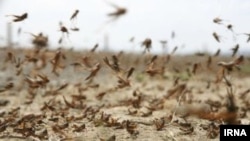An official of the Iranian Agriculture Ministry on Monday said a huge new wave of locusts is expected to invade the southern provinces of Iran in two weeks.
In late February and early March massive swarms of desert locusts (Schistocerca gregaria) invaded the southern regions of Iran.
The locusts that destroy all crops along their way have been wreaking havoc in various African countries including Ethiopia, Kenya and Uganda in the past few weeks. According to the United Nations Food and Agriculture Organization (FAO) desert locusts are a serious threat to food safety in these countries. FAO has requested nearly $140 million dollars to combat the locust threat across the affected areas.
In view of the impending arrival of locust swarms in Iran FAO has increased its Emergency Technical Cooperation project (TCP) to help battle the swarms of locusts and will grant Iran a total of $500,000 for urgent action to control desert locust infestation.
The plan will help enhance the country's technical capacity for early warning, monitoring and management of the destructive pest.
Keith Cressman, the executive secretary of FAO Commission for Controlling the Desert Locust in Southwest Asia (SWAC), has said that widespread rains over the last couple of months in East Africa and Southwest Asia, including southern Iran, provided a conducive environment for the desert locusts to breed.
“FAO has implemented similar projects in Pakistan, Yemen and East African nations, all aimed at supporting its member states in managing the threat posed by the desert locust,” he was quoted on Sunday by Financial Tribune as saying.
The Iranian government has so far allocated 250 billion rials (nearly $6 million) to combat the locust threat in one million hectares of agricultural land, particularly in the south of the country where the worst affected regions lie. According to Mohammad-Reza Dargahi, Chief of the Plant Preservation Organization of the Ministry of Agriculture, an additional 300 billion ($6.12 million) is to be allocated to combat the locust.
“The pest has been confronted chemically using different methods from land and air. The provinces of Sistan-Baluchestan, Hormozgan, Bushehr, Fars, Khuzestan and southern Kerman have been so far infected,” Mehr News Agency reported him as saying.
In April 2019 locusts destroyed crops in at least 200,000 hectares of Iran's agricultural lands. The worst ever was in 1961 when locusts infected and damaged crops in about 2.5 million hectares of land.







